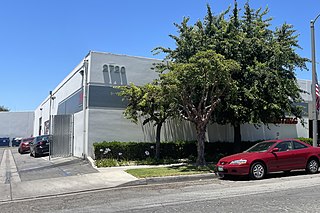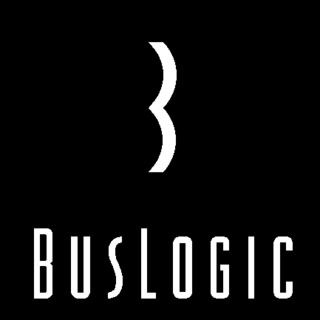
The Intel 386, originally released as 80386 and later renamed i386, is a 32-bit microprocessor designed by Intel. The first pre-production samples of the 386 were released to select developers in 1985, while mass production commenced in 1986. The processor was a significant evolution in the x86 architecture, extending a long line of processors that stretched back to the Intel 8008. The 386 was the central processing unit (CPU) of many workstations and high-end personal computers of the time. The 386 began to fall out of public use starting with the release of the i486 processor in 1989, while in embedded systems the 386 remained in widespread use until Intel finally discontinued it in 2007.
Packard Bell Electronics, Inc. was an American computer company independently active from 1986 to 1996, now a Dutch-registered computer manufacturing brand and subsidiary of Acer Inc. The company was founded in 1986, after Israeli-American investors bought the trademark rights to the Packard Bell Corporation from Teledyne. The investors wanted to name their newly formed personal computer manufacturing company producing discount computers in the North American markets.

Gateway, Inc., previously Gateway 2000, Inc., was an American computer company originally based in Iowa and South Dakota. Founded by Ted Waitt and Mike Hammond in 1985, the company developed, manufactured, supported, and marketed a wide range of personal computers, computer monitors, servers, and computer accessories. At its peak in the year 2000, the company employed nearly 25,000 worldwide. Following a seven-year-long slump, punctuated by the acquisition of rival computer manufacturer eMachines in 2004 and massive consolidation of the company's various divisions in an attempt to curb losses and regain market share, Gateway was acquired by Taiwanese hardware and electronics corporation Acer, in October 2007 for US$710 million.

AST Research, Inc., later doing business as AST Computer, was a personal computer manufacturer. It was founded in 1980 in Irvine, California, by Albert Wong, Safi Qureshey, and Thomas Yuen, as an initialism of their first names. In the 1980s, AST designed add-on expansion cards, and evolved toward the 1990s into a major personal computer manufacturer. AST was acquired by Samsung Electronics in 1997 but was de facto closed in 1999 due to a series of losses.

Zenith Data Systems Corporation (ZDS) was an American computer systems manufacturing company active from 1979 to 1996. It was originally a division of the Zenith Radio Company, after they had purchased the Heath Company and, by extension, their Heathkit line of electronic kits and kit microcomputers, from Schlumberger in October 1979. ZDS originally operated from Heath's own headquarters in St. Joseph, Michigan. By the time Zenith acquired Heathkit, their H8 kit computer already had an installed fanbase of scientific engineers and computing enthusiasts. ZDS' first offerings were merely preassembled versions of existing Heathkit computers, but within a few years, the company began selling bespoke systems, including the Z-100, which was a hybrid 8085- and 8088-based computer capable of running both CP/M and MS-DOS.

Mylex Corporation was an American computer company active from 1983 to 1999. The company mainly produced peripherals and expansion cards for personal computers—chiefly the IBM Personal Computer—for the bulk of its existence, although it also produced complete motherboards. In the mid-1990s the company focused on designing and manufacturing RAID controllers, eventually cornering 75 percent of the RAID controller market. In 1999, the company was acquired by and made a subsidiary of IBM for approximately $240 million. In 2002, IBM sold their Mylex division to LSI Logic for an undisclosed amount.

The Sharp PC-7000 is a luggable portable computer released by Sharp Electronics in 1985. The PC-7000 was Sharp's second entry into the IBM PC-compatible portable computer market, their first being the PC-5000.

The PCradio was a notebook computer released by International Business Machines (IBM) in late 1991. Designed primarily for mobile workers such as service technicians, salespersons and public safety workers, the PCradio featured a ruggedized build with no internal hard disk drive and was optioned with either a cellular or ARDIS RF modem, in addition to a standard landline modem.

American Computer & Peripheral, Inc. (AC&P), also written as American Computer and Peripheral, was an American computer company based in Santa Ana, California. The company was founded in 1985 by Alan Lau and released several expansion boards for the IBM PC as well as a few PC clones before going bankrupt in December 1989. Obscure in its own time, the company's 386 Translator was the first plug-in board for Intel's newly released 80386 processor and the first mass-market computing device to offer consumers a means of using the 386 in July 1986.

OCR Systems, Inc., was an American computer hardware manufacturer and software publisher dedicated to optical character recognition technologies. The company's first product, the System 1000 in 1970, was used by numerous large corporations for bill processing and mail sorting. Following a series of pitfalls in the 1970s and early 1980s, founder Theodor Herzl Levine put the company in the hands of Gregory Boleslavsky and Vadim Brikman, the company's vice presidents and recent immigrants from the Soviet Ukraine, who were able to turn OCR System's fortunes around and expand its employee base. The company released the software-based OCR application ReadRight for DOS, later ported to Windows, in the late 1980s. Adobe Inc. bought the company in 1992.

DTK Computer is the name for international branches of Datatech Enterprises, a Taiwanese computer manufacturer. Founded in 1981, the company was an early supplier of peripherals for IBM PCs as well as PC compatible motherboards. In the late 1980s, the company switched to developing complete systems under the DTK name as well as serving as an OEM for motherboards and cases, as bought by other small computer companies and systems integrators.

CMS Enhancements Inc. was an American computer company headquartered in Irvine, California. Founded in 1983, the company's main product lines in the 1980s were internal and external hard drives and tape drives. The company's hard drives were chiefly sourced from Seagate and reconfigured in bespoke configurations for certain computing platforms, such as the Macintosh, the IBM PC, and the Compaq Deskpro, among others.

The Personal System/2 Model 25 and its later submodels the 25 286 and 25 SX are IBM's lowest-end entries in the Personal System/2 (PS/2) family of personal computers. Like its sibling the Model 30, the Model 25 features an Industry Standard Architecture bus, allowing it to use expansion cards from its direct predecessors, the PC/XT and the PC/AT—but not from higher entries in the PS/2 line, which use Micro Channel. Unlike all other entries in the PS/2 line, the Model 25 and its submodels are built into an all-in-one form factor, with its cathode-ray tube (CRT) monitor and system board occupying the same enclosure. IBM oriented the Model 25 at home office workers and students.
IBM EduQuest, later shortened to EduQuest, was a subsidiary of American multinational technology corporation IBM that catered to the elementary and secondary educational market. A spin-off of the company's Educational Systems division spearheaded by James Elton Dezell Jr. (1933–2000), EduQuest developed software and hardware for schools. Most prominent was their line of all-in-one personal computers, whose form factor was based on IBM's PS/2 Model 25.

Cumulus Corporation was an American computer peripheral and system manufacturer active from 1987 to 1993. Based in Beachwood, Ohio and started by Tecmar founder Martin Alpert, the company set out to exclusively manufacture expansion products for IBM's Personal System/2 (PS/2) family of computers—mainly RAM expansion cards. It later released cross-platform CPU upgrade cards and memory expansion cards for other platforms besides the PS/2. Beginning in 1990, the company began trading as Cumulus Computer Corporation and began releasing complete systems of their own. Initially a success story for the tech industry in Cleveland, a botched stock launch in 1992 proved disastrous for the company's ailing cash flow situation, and in 1993 the company was liquidated amid massive debt to suppliers and lenders.

TriGem Computer Co., Ltd., was a South Korean personal computer manufacturer and technology company. Established in 1980, TriGem was the first Korean company dedicated to manufacturing computer systems. It delivered Korea's first microcomputer in 1981 and the first Korean IBM PC compatibles in 1984. From that point until its breakup in 2010, it alternated between the first- and second-largest computer manufacturer in South Korea, competing with Samsung Electronics.
Ogivar Technologies Inc. was a Canadian computer company founded in Montreal, Quebec, in 1982 and 1992. Active for roughly a decade, the company primarily manufactured IBM PC compatibles before having the majority of its assets bought out by Tandem International, a electrochemical company, following bankruptcy proceedings. It was once one of Canada's top manufacturers of personal computers.

BusLogic, Inc., was an American computer company active from 1988 to 1996. It specialized in the production of Small Computer System Interface (SCSI) device controller chips and controller expansion cards, becoming a dominant player in that market, behind only Adaptec. In 1996, the company was acquired by Mylex Corporation.
New Media Corporation, also known as New Media Technology Corporation, was an American computer company active from 1992 to the early 2000s. The company focused on the design and manufacture of PC Cards, a type of expansion card bus for laptops that had their heyday from the early 1990s to the mid-2000s. New Media was privately held and based out of Irvine, California.


















